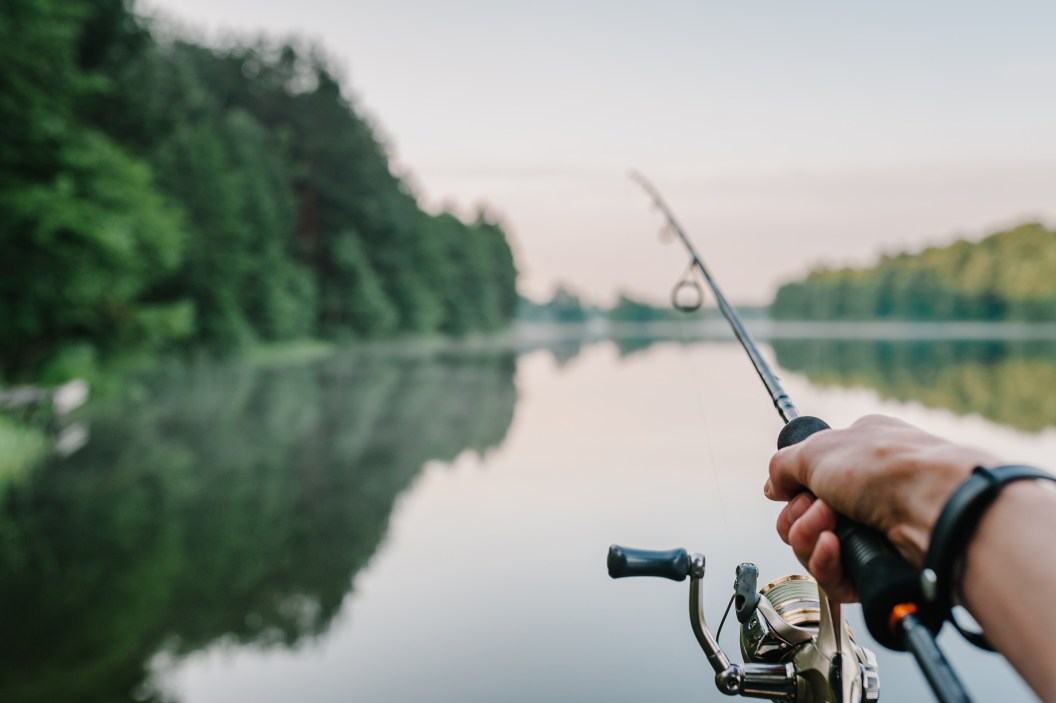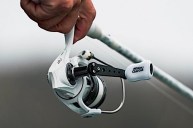Few activities are as enjoyable as a day out fishing with friends, family or—best yet—a day fishing solo. But for many outdoors enthusiasts looking to try fishing for the first time—or to improve their skill set—purchasing a new fishing rod can be a daunting task.
At its most basic, fishing requires a rod, a reel, a line, a hook, and something to tempt the fish to eat, such as a worm or an artificial bait or lure (same thing, different words). Your rod is arguably the most expensive purchase. It's what helps you get the hook and bait where they need to be, and it serves as your lever for pulling in the fish on the other end of the line.
So how does one go about tackling the breadth of rod offerings available? It can seem like an impossible task to navigate the sea of options. A fast or a slow rod? Short or long? Graphite, fiberglass, or composite material? But rod selection is actually deceptively simple.
As an angler who's been fishing since I could hold my first rod—it was a pink Barbie rod; I've since graduated—and has fished on six continents for a variety of species, I've come to learn my rod preferences. And while it can take a while to learn your own, here's a primer on what you can look for in your next rod.
Best Fishing Rods of 2023
- Best Fishing Rod Overall: Ugly Stik Elite Spinning Rod
- Best Budget Fishing Rod: PLUSINNO Eagle Hunting 9 Telescopic Fishing Rods
- Best Fishing Rod for Beginners: Bass Pro Shops AirStream PTC Spinning Rod
- Best Bass Fishing Rod: KastKing Royale Select Casting Rod 76XH1
- Best Saltwater Fishing Rod: Shimano GLF Inshore Spinning Series
- Best Splurge Fishing Rod: St. Croix Legend X Spinning
- Best Panfish and Sunfish Rod: St. Croix Panfish Series
Best Overall
Top Pick: Ugly Stik Elite Spinning Rod ($50 and up)
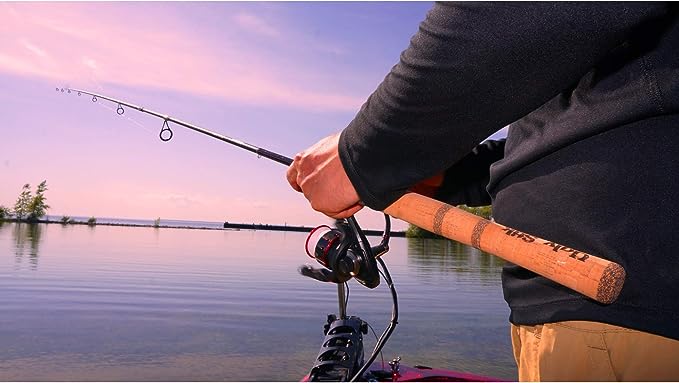
Ugly Stik
The Ugly Stik Elite Spinning Rod is a great value for the money and suits a variety of fishing styles, from fresh to saltwater. It's available in multiple weights, lengths, and actions to allow anglers to choose their own preferences. Choose among rod weights and lengths for a variety of fishing, from small freshwater species such as panfish (we like the 5'6" lightweight, fast-action rod here) to large bass in open lakes (go for the 7'6" medium-fast action, medium-light rod).
We appreciate the look and hand comfort of the cork-covered grips, which are designed to perform even in wet, cold conditions. The exposed, blank-style reel seat accommodates a variety of reels while holding them securely. The rod is sensitive while retaining the reliability and durability for which the brand is known. Single-piece stainless steel guides allow the line to flow smoothly while preventing pop-outs; and they increase longevity, which means the rod will likely last quite a few seasons in your quiver.
The only downside we found is it's slightly heavier than we'd expect, but that's a minute—and likely unnoticeable—issue for most recreational anglers.
- Multiple lengths and actions are available, depending on your fishing style
- Cork-covered grip won't get slippery when wet
- Blank-style reel seat holds a variety of reels securely
- Stainless steel rod is both sensitive and sturdy
- This fishing gear is available on Amazon
- Heavier than some options, though by no means a dealbreaker
Best Budget Fishing Rod

PLUSINNO
Top Pick: Eagle Hunting 9 Telescopic Fishing Rods ($50)
Whether you're just getting into fishing and looking for a rod that will perform decently without breaking the bank, or you're an experienced angler looking to add another rod to your quiver, the PLUSINNO Eagle Hunting IX Telescopic Spinning Rod is not to be overlooked. The carbon composite blank construction delivers strength and sensitivity, delivering a balanced, lightweight design. The anti-winding tip helps prevent the line from twisting, and a high-density split-grip EVA (ethylene vinyl acetate) grip flows right into the reel seat, maximizing blank exposure to help improve sensitivity.
This medium-power, fast-action rod is a great intro rod for a variety of fishing: bass, trout, catfish, walleye—whatever target you're eyeballing, this rod is a good place to start. The ergonomic cork handle is well-designed and surprisingly comfortable for long days of fishing. We weren't huge fans of the plastic reel seat, which feels a little cheap, though it seemed to sturdily lock the reel into place and we experienced no performance issues. It also packs down smaller than other rods we reviewed thanks to the telescopic feature, which is a great feature for traveling anglers. This could be a great rod for kids who might be a little harder on their gear, as it's readily replaceable without breaking the bank.
Best for Beginners
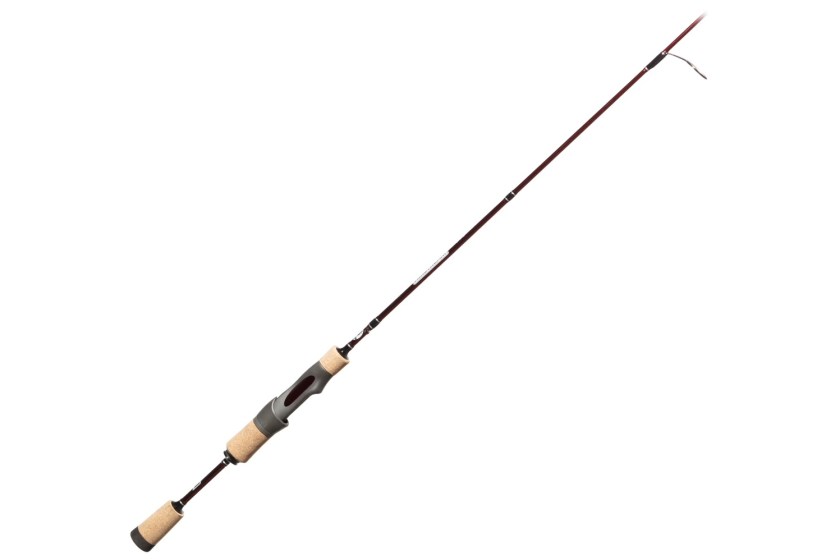
Bass Pro Shops
Top Pick: Bass Pro Shops AirStream PTC Spinning Rod ($60)
Most beginning anglers will start off at their local bass pond, trout stream, or crappie-filled lake. If you're looking for a rod to pick up and play with this season, Bass Pro Shops' AirStream PTC Spinning Rod is a good place to start. The "PTC" stands for "panfish, crappie, trout," and this rod was developed specifically for quiet presentations to spooky fish, which will help beginner anglers get the hang of targeted finesse casting before moving on to bigger prey.
The ultra-light rod is easy to cast all day long without wearing new fishers out. And it performs well with small bait and light strikes, leading to more hook-ups for new fishers than a fast-action rod would.
The rod is built on an RT2 blank with powerful-yet-responsive graphite, with a layering pattern designed to reduce weight and improve sensitivity. The stainless steel guides felt as if they provided more control for smoother casting, and a well-made reel seat pairs with a split-grip, rubberized cork handle for comfort and enhanced sensitivity.
While this rod doesn't have the backbone to go after larger prey in the saltwater or even larger freshwater fish, it's an ideal rod for beginners to learn proper technique and fish handling before moving onto larger fish in a variety of environments. And, considering that most fishers have a bass, crappie or trout pond nearby, odds are it's a rod that will remain in the quiver even once additional rods are purchased later on.
Best Bass Fishing Rod

KastKing
Top Pick: KastKing Royale Select Casting Rod 76XH1 ($53 and up)
KastKing's Royale Select Casting Rods come in a variety of options, but our favorite for bass is the Royale Select 76XH1 bait caster rod. It features a 7'6" length, a fast taper, and a rating for 14-to-30-pound line. If you're cruising the lily pad line and tossing bulky lures such as paddle baits of frogs, this workhorse of a rod can help tow the lures back into the open water again without a snag.
KastKing's rod blanks have the backbone to muscle a big summer bass from deep cover. They're constructed to balance performance and sensitivity, aiding in casting reach without losing that fine feel needed for a good hookset. The one-piece design offers anglers increased feel and casting precision.
- Strong, long rod has a fast taper and a 14- to 30-pound line rating that's no match for bass
- One-piece design balances performance and sensitivities for casting and feel
Best Saltwater Fishing Rod

Shimano
Top Pick: Shimano GLF Inshore Spinning Series ($100)
By far our choice for saltwater fishing, the Shimano GLF Inshore Spinning Rods are veritable rock stars for the sea. These rods cover the ocean bases, with each model in the line designed for the species the angler chooses to target, from sea trout and flounder to redfish and snook. Though angled toward Gulf Coast fishers, anyone who spends time on the ocean will appreciate these thoughtfully designed rods.
The lightweight, fast-action rod blank is made from a hybrid graphite, designed for inshore fishing techniques that require both a burly backbone and good casting feel. The aluminum oxide guides handle either braided or mono lines with ease, giving the angler the option to choose their favorite for the conditions. The reel seat feels rock-solid and secure, even when fighting big fish; and the cork and EVA handle grip stay comfortable through sweaty or rainy days on the water. Overall, no complaints on this rod—it's one we'd reach for time and time again.
- Rods are designed based on the type of fish targeted
- Graphite construction offers a stiff backbone and a good casting feel
- Can be used with braided or mono fishing line
- The handle is extra-grippy even when wet
Best Splurge Fishing Rod
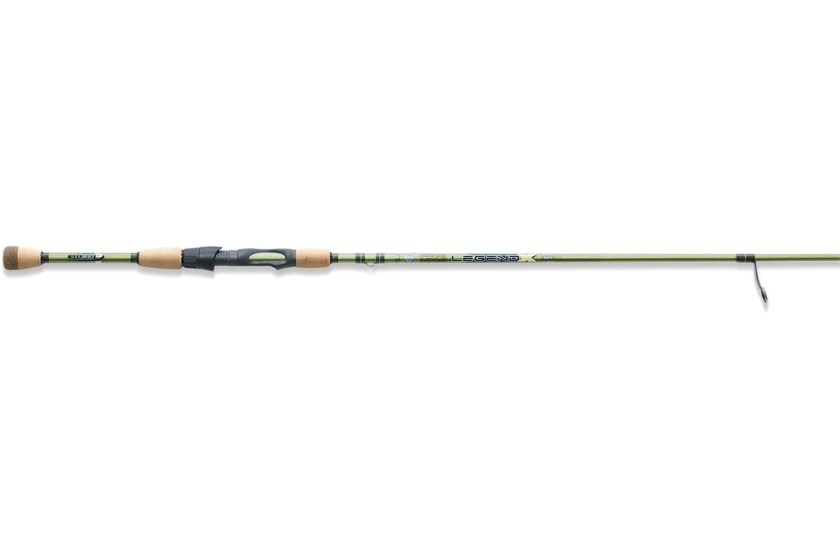
St. Croix
Top Pick: St. Croix Legend X Spinning ($465)
St. Croix rods often come in at a premium price—but for serious anglers doing serious fishing, they're worth the money. Our choice for fast-action spinning rods, the St. Croix Legend X Series, is lightweight with superb balance, making for comfortable all-day fishing. The rods' stiff backbones offer enough leverage for wrestling big fish from heavy cover, as well as for setting the hook quickly and working fish to the boat with no waste of time. This series has found that magical combination of lightness while retaining strength and responsiveness—a feature fishers will appreciate during long days on the water.
The Legend X series was designed to eliminate all transitional points in the rod blank, which is made from a carbon fiber material the brand dubs "Advanced Reinforcing Technology" that claims to offer 10 times the strength without adding to blank diameter or weight. This helps prevent the rod from warping or "ovaling" under a strong load. The Taper Enhancement Technology blank design provides curved patterns for improved action with increased sensitivity, while super high-modulus SCVI carbon with FRS in the lower section provides for maximum power and strength with reduced weight.
The rods are outfitted for saltwater use, with guides made of a smooth, light material called Torzite and titanium frames that won't corrode. The spinning rods feature Fuji TVS blank-touch reel seats with built-in hood, while the Legend X casting rods boast the Fuji PTS blank-touch reel seat with built-in hood. The cork handle remains comfortable and grippy during long, salty days, and the slow-cure finish adds to the rods' durability.
As long as you're willing to spend the money and invest in a quality rod, you'll find no complaints about St. Croix's Legend X Series. The rods are a dream to fish.
Best Panfish and Sunfish Rod

St. Croix
Top Pick: St. Croix Panfish Series ($120)
A good panfish and sunfish rod offers a superb feel while also providing enough backbone that you could toss to a lurking bass if the opportunity arose. The St. Croix Panfish series fills the bill, offering a variety of lengths, powers, and actions available to suit various fisheries, rigs, and angler tastes. Super comfortable when paired with small jig and plastic combos, this series can handle mid-size jigs comfortably while still retaining enough finesse and feel for small fish.
The Panfish Series Spinning Rod features a carbon fiber blank, which is lighter but also stronger than previous models; and it's topped off with two coats of a flexible, strengthening slow-cure finish. The rod is coated with a resin system technology to add durability—key for lightweight rods such as this series—and the blank has enough backbone to manage head shakes and keep fish working without sacrificing feel.
As expected from a St. Croix rod, the components hold up to precision inspection as well. Strong guides with stainless steel rings and frames ensure smooth flow of the line. A PVD-coated tip-top aids durability and longevity, and a strong reel seat ensures the reel doesn't migrate when fighting large fish. The rod is comfortable to hold and manage, thanks to a cork butt, mid, and foregrip on split-grip models, and a full cork handle and foregrip on the 8- and 9-foot models. Overall, these rods deliver high performance and feel at a reasonable price.
What To Look for When Buying the Best Fishing Rod for You
Regardless of your prior experience fishing, answering three key questions will enable you to whittle down your potential rod section.
Saltwater or freshwater? Lakes or rivers? If you got in your vehicle right now and headed to the water that's inspired you to fish, what does it look like? Realizing that at some point in your fishing career you'll likely do all of those things, where are you starting?
Again, you'll likely chase many different fish throughout your lifetime. But right now, in that target water, what's swimming around? Do you live in the mountains and plan to fish a freestone river that's only 40 feet at its widest point? Or are you on the Gulf Coast and hoping to go cast off your buddy's boat in the hopes of hooking a sea trout? Maybe you're an aspiring Midwestern angler hoping to go chase bass on the neighborhood pond with the kids. Figure out what kind of fish you'll most often be fishing for, and plan accordingly.
If you'll be tossing big plugs up in the Northeast, that's likely going to require a different gear setup than that neighborhood bass pond you're planning to target with a Styrofoam box of worms or when throwing treble hooks for trout or big saltwater lures while hunting for tarpon down in the Keys. Each of these different methods of fishing is going to require different rods to get the bait into the target zone.
If you're not sure what to rig up, check out:
Fishing Rods 101: The Basics
Rod "flex" and "speed" both refer to the action of the rod: How does it act when it's being thrown and when you're bringing in your catch? It also accounts for how quickly the rod will resume its straight position after being thrown, or "loaded."
Rod manufacturers typically rank rod action on an intuitive slow-to-fast scale. This scale will slide somewhat with the individual angler's experience and how they handle the rod, but thinking of them as slow or fast gives a basic starting point.
- Slow rods bend or "flex" more in the cast and can feel bouncier when fighting fish. These rods can often bend all the way to the butt of the rod near the grip, offering a lot of feel on even small panfish or creek trout. Slow-action rods are often best suited for smaller lures and bait; the smaller the weight on the end of the line, the easier it will be to cast with a slow-action rod. Smaller lures and bait will also be easier to catch fish with when using a slow rod. Because the hook set is slower, it takes time for the hook to lodge in the fish's mouth. Small hooks can often be placed quickly and effectively, whereas larger hooks and lures can take longer to lodge properly in the fish's mouth. It's a game of odds, so best to put the odds in your favor when possible.
- Fast rods are much stiffer and can help anglers feel minute vibrations when fighting fish, but they can be more work to throw and sometimes offer less "play" in the fish fight. Fast-action rods bend only at the very top and can rebound back to their straight shape very quickly, allowing for a quick, powerful hook setting. Fast rods are better for pulling fish out of heavy cover and are the typical rod of choice for anglers looking to pursue larger fish species, such as muskie, pike, or beefy largemouth in freshwater, or tuna, tarpon, and even billfish in saltwater. But for anglers who like the battle—the feeling of reeling in a bouncy fish and taking their time with the process—fast-action rods can be too stiff.
- Medium rods land in a space between the finesse-minded, slow-action rods and the rough-and-ready, fast-action rods. A medium-action rod will bend in the top half of the rod and have enough backbone to allow an angler to cast fairly far while still maintaining a bit of finesse for multi-hook setups and more feel than a fast heavy-action rod. A medium-action rod can be a versatile addition to the quiver for an angler who would like to fish a variety of water using one rod.
A rod's strength is often referred to as "power" and identifies the rod's resistance to being bent or withstanding pressure. Does it take a lot of weight or a strong, steady pull to bend the rod on a fish? That's heavy power—good for muscling fish from cover or for rapid hook sets where finesse isn't of great concern.
On the other hand, if the rod keels right over in a deep arc, it has light power. Lighter-power rods can be used for finesse angling in tight spaces with lighter lures and thinner lines.
Generally, heavier rods are better suited to big fish and lighter rods to smaller fish. It's logical: Heavier rods can support heavier lines and tackle, while lighter rods can focus on the details with lighter lines and tackle.
The rod blank—the body of the rod—will often have rod power noted in small print. The power scale for most manufacturers runs in a scale from Ultra Light, Light, Medium, Medium Heavy and Heavy, to Ultra Heavy. It's worth noting that "heavy" in a trout rod and "heavy" in an offshore fishing rod are two different worlds; you must view this scale within the rod family or use category in which you're shopping.
Another key consideration is rod length. Rods can range anywhere from 4 to 14 feet, depending on the intended use and the target species. Rod length affects how far you're able to cast—there's a reason surf casters often use rods well over 12 feet. And while a long rod and an even longer cast sound great, there's a tradeoff: Longer rods are harder to maneuver and manage, especially in small boats or in close quarters with bushes, trees, or mangroves.
Shorter rods often provide more control—but, naturally, that control comes at the price of casting distance. If you're mostly fishing from a boat and don't have to cast very far, short rods can be much easier to manage. They're also more powerful when fighting large fish; therefore, most rods used for trolling for larger species are quite short. Most fishers will take the middle ground of a 7- or 8-foot rod if they're looking for an all-around workhorse.
Most modern fishing rods are crafted from one of three materials: graphite, fiberglass, or composite. Again, much of the decision of which to choose falls to personal preference. Some anglers may have grown up with a certain kind of rod material that now, as adults, feels familiar and just right. Newer fishers may have used a friend's rod and liked whatever they happened to start with. But barring an existing personal preference, some rod materials are better suited to certain uses and angling types.
- Fiberglass: Many of us grew up fishing with fiberglass rods. Durable, strong, and offering a good "feel" from the fish once it's hooked, fiberglass tends to be reasonably priced as well. Thanks to their durability, fiberglass rods can be passed down from generation to generation; many well-traveled anglers reminisce happily about fishing their granddad's old fiberglass rod when they were kids. This classic material comes with a few downsides, though. Fiberglass tends to be heavy, which can wear on an angler during a full day of casting or if fighting a fish for an extended period. The pliability of fiberglass can also make it harder to detect very subtle takes, and then to set quickly when a fish does bite.
- Graphite: Another familiar rod material, graphite disrupted the fiberglass rod tradition in 1973, when rod manufacturer Fenwick introduced the first all-graphite fishing rod. Lighter and stronger than fiberglass, graphite rods are also stiffer, which suits anglers who don't favor the slower action of fiberglass. The firm, fast-action graphite isn't a fit for everyone, however; anglers who like slower, more subtle takes and the pronounced cast of a slow-action may still prefer fiberglass. Graphite rods are typically made from graphite compounds or machined graphite and are known for thermal shock resistance (which improves durability), good aging (graphite is a non-fatiguing material), and high resistance to corrosion.
- Composite: Maybe the slow, subtle action of fiberglass isn't for you, and the fast, crisp feel of graphite leaves you cold. Time to try out a composite rod—a mixture of the two. More sensitive than graphite, composite rods also tend to be lighter in hand. Imagine the finesse of fiberglass combined with the durability of a graphite rod, and you've got yourself a good composite. Anglers looking to buy one rod often gravitate toward composite rods, and for good reason. Their combination of strengths allows fishers to tackle different waters, from tight little waterways that require more finesse to open water with larger fish that might require a slightly longer cast and quicker set. The, ahem, catch is that composite rods tend to be more expensive than either straight graphite or fiberglass rods.
Who We Are
A seasoned international writer and photographer, Jess McGlothlin has more than 15 years of experience fly-fishing on six continents. Getting her start fly fishing in Montana from a young age, McGlothlin has also helped run lodges and guide teams around the world; and she has written about angling for audiences in the U.S., U.K., mainland Europe, South Africa, and Australia. She's admittedly a bit obsessive about finding the best gear for the job; and for this piece, she relied on the fishing experience of a variety of industry professionals—on a variety of species—who were more than happy to share their experiences and options (along with a fishing story or two).
READ MORE: The Best Topwater Lures We've Used in 50+ Years on the Water
